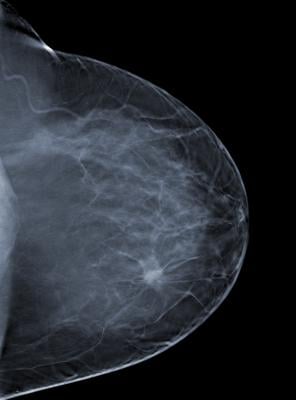
February 2, 2016 — Investigators from Brigham and Women's Hospital (BWH) and the Dana-Farber Cancer Institute have found that a set of easily measurable risk factors can predict the magnitude of survival benefit offered by radiation therapy following breast cancer surgery for ductal carcinoma in situ (DCIS). Their results appear online in the Journal of Clinical Oncology on Feb. 1.
Approximately 60,000 patients in the United States will receive a DCIS diagnosis in 2016. DCIS is not an invasive form of cancer and the 10-year survival rate for women with DCIS is greater than 98 percent. However, incidence of DCIS has increased dramatically over the last three decades, and being able to determine which women are among the small percentage at higher risk of breast cancer recurrence and mortality could help clinicians and patients tailor treatment to neither over- nor undertreat the disease.
"DCIS has a very low breast cancer mortality, which means that as an oncology community, we must be cognizant of overtreatment," said co-senior author Mehra Golshan, M.D., Al-Tuwaijri Family Distinguished Chair of Surgical Oncology at Dana-Farber/Brigham and Women's Cancer Center. "Radiation therapy after breast cancer surgery has become a widely accepted treatment option for patients undergoing breast conserving therapy (or lumpectomy) with DCIS. Our results provide information that can guide individual treatment options, and better predict survival benefit from radiation therapy based on an individual's case."
For their retrospective, longitudinal study, Golshan and colleagues examined data from more than 32,000 patients treated for DCIS; this included more than 20,000 who received radiation therapy and breast cancer surgery, and more than 11,000 who received breast cancer surgery alone. Breast cancer mortality rates at 10 years were low for both groups: 1.8 percent for the group that received radiation therapy and 2.1 percent for the group that did not.
The team then assigned each patient a validated prognostic score on a scale of zero to six based on a set of three risk factors: nuclear grade (a measure of how abnormal cells look under a microscope); patient's age; and tumor size. Patients with a higher nuclear grade, younger age and/or larger DCIS received a higher score; those with a lower nuclear grade, older age and/or smaller DCIS received a lower score. Past studies have shown that a patient's prognostic score can predict breast cancer recurrence, but such scores had not previously been used to assess the effectiveness of treatment decisions on long-term breast cancer survival.
The team found that for patients with higher prognostic scores, radiation therapy conferred a significant survival benefit. Those with scores of four or five saw a near 70 percent reduction in breast cancer mortality if they received radiation therapy. For patients with low scores, however, there was no significant difference in breast cancer mortality with or without radiation therapy.
"Using three factors that are routinely measured, we can predict whether there will be a survival benefit or no survival benefit for patients receiving radiation therapy," said lead author Yasuaki Sagara, M.D., of the BWH Department of Surgery and Dana Farber/Brigham and Women's Cancer Center and chief of breast oncology at Hakuaikai Medical Cooperation in Japan. "Our finding suggests, for the first time, that patients with more aggressive cancer who are at higher risk may actually live longer if they are treated with radiation therapy."
The authors note that although radiation therapy provides negligible survival benefit for low-risk patients, other studies have found that radiation therapy can reduce the rate of local recurrence even among patients with low prognostic scores. Given such complexities, the authors recommend thorough counseling about the risks and benefits of radiation therapy for informed decision making.
For more information: www.brighamandwomens.org


 April 18, 2024
April 18, 2024 








